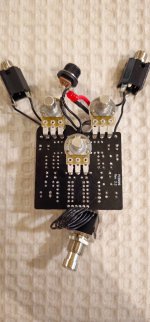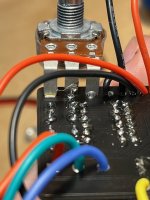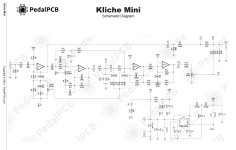Hello,
I recently built the Kliche Mini, assembled in the enclosure, and got it working perfectly, which I was very happy with as a first build. Maybe the 4th or 5th time I played it, all of a sudden I have no sound both bypass or turned on. I read through some past forum questions to try and get a handle on this myself, resoldered around the IC holders, studied the schematics as best I could understand them, built an audio probe, and now I'm stuck!
The circuit turns on, led lights up, no sound at all. Testing with the audio probe, I can get audio From In, R1, C1, and pin 3 of IC1, where there it dies. Not sure its relevant, but I tried swapping the TL072 IC's (IC1 and IC2) and then I get no audio out from C1.
I measured the DC on both TL072's and the TC1044SCPA and got the following:
IC1-
1- 3.4
2- 3.4
3- 7.3
4- 0
5- 8
6- 8
7-8.6
8- 9.1
IC2-
1-7.7
2- 7.7
3-8
4-8
5- 8
6-8
7- 7.9
8-8.3
IC3-
1- 9.1
2- 9.1
3- 0
4 - 9.1
5- 8
6-8.6
7- 8.6
8- 9.1
Sorry for the long winded post, I was so excited that I got this pedal working right out the gate, it sounded incredible with my bassman...and then not!
Thanks in advance....
Photos incoming....
I recently built the Kliche Mini, assembled in the enclosure, and got it working perfectly, which I was very happy with as a first build. Maybe the 4th or 5th time I played it, all of a sudden I have no sound both bypass or turned on. I read through some past forum questions to try and get a handle on this myself, resoldered around the IC holders, studied the schematics as best I could understand them, built an audio probe, and now I'm stuck!
The circuit turns on, led lights up, no sound at all. Testing with the audio probe, I can get audio From In, R1, C1, and pin 3 of IC1, where there it dies. Not sure its relevant, but I tried swapping the TL072 IC's (IC1 and IC2) and then I get no audio out from C1.
I measured the DC on both TL072's and the TC1044SCPA and got the following:
IC1-
1- 3.4
2- 3.4
3- 7.3
4- 0
5- 8
6- 8
7-8.6
8- 9.1
IC2-
1-7.7
2- 7.7
3-8
4-8
5- 8
6-8
7- 7.9
8-8.3
IC3-
1- 9.1
2- 9.1
3- 0
4 - 9.1
5- 8
6-8.6
7- 8.6
8- 9.1
Sorry for the long winded post, I was so excited that I got this pedal working right out the gate, it sounded incredible with my bassman...and then not!
Thanks in advance....
Photos incoming....




